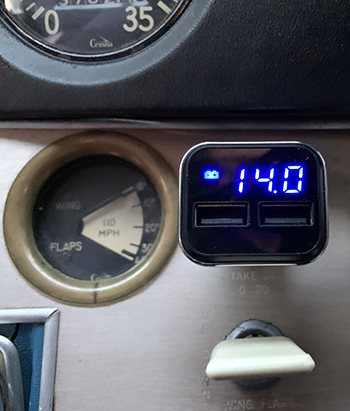Subscriber question:
"How can I be sure if my charging system is functioning correctly? All I have is the original ammeter in my instrument panel." — Kyle T.
Dean:
 “The simple solution is adding a digital voltmeter. It’ll cost less than 30 dollars if you have a cigarette lighter receptacle.
“The simple solution is adding a digital voltmeter. It’ll cost less than 30 dollars if you have a cigarette lighter receptacle.
A quick search online will reveal many options that plug into the lighter adaptor. Just make sure it’s rated for a 24-volt system if that’s what your airplane uses. As a bonus, many of them have USB charging ports built in. If you plan to charge an iPad, though, make sure the ports are rated to at least 2.1 amps. Three amps is ideal.
The digital voltmeter makes an excellent troubleshooting tool—and it shouldn’t read only 12 or 24 volts.
A healthy 12-volt charging system reads about 14 volts in flight. That’s needed to replenish the battery. That value of about 14 volts should stay the same no matter how many electrical items you turn on. Seeing much less than 14 volts could mean your generator or alternator isn’t keeping up with demand, even though your ammeter reads about normal. Seeing less than 12 volts probably means you’re running on battery power. You should see a discharge on your ammeter at that point.
For a 24-volt system, you should see about 28 volts in flight.
With a voltage indicator plugged into the cigarette lighter, you can monitor your charging system at a glance. You’ll know the moment voltage dips so you have maximum time to find an airport with repair services.
Until you get that fancy instrument panel upgrade, this is an option that requires no logbook entry. And it just might save your life some dark stormy night when your alternator stops working.”
If your alternator failed two hours from home on a CAVU-day, VFR flight, would you consider turning off the master and continuing home?
(Assume you can get the alternator fixed at your home airport.)
